Nerine Dorman's Blog, page 32
September 27, 2018
Cuddle Me, Kill Me by Richard Peirce
I remember my first encounter with lions like it was yesterday. I was about eight or nine, and my parents took me on a trip upcountry so we could visit family in Pretoria. One of the attractions we saw along the way was a lion park near Joburg. But perhaps the biggest appeal to the experience was that I got to feed the lion cubs afterwards, and had my photo taken with them. We were told that the cubs were orphaned, and that they were being bred for “conservation purposes”. Little did I know back then that in all likelihood, these cubs were never intended to be released in the wild but were almost certainly destined for the canned lion hunting industry. We were being fed one of the most common lies spewed by unethical operators.
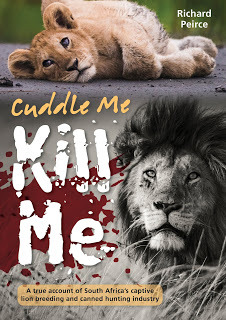 Cuddle Me, Kill Me by Richard Peirce picks up where films like Blood Lions did much to blow the lid off of one of South Africa’s greatest shames – the large-scale breeding of predators for commercial purposes.
Cuddle Me, Kill Me by Richard Peirce picks up where films like Blood Lions did much to blow the lid off of one of South Africa’s greatest shames – the large-scale breeding of predators for commercial purposes.
This is not an easy book to read, because it brings me face to face with the ethics of captive breeding of lions and other large predators. I ask myself, is this any different than our factory farming of livestock for consumption? What makes it right for us to enjoy bacon when we disparage lion farming? It makes me examine the human relationship with other sentients on this planet, and I don’t like what I see.
The crux of the matter, as put forward by Peirce, is that captive breeding of lions has absolutely no conservation value whatsoever. Lion farms do not create more jobs or boost the economy significantly, no matter what the Department of Environmental Affairs says; breeding farm workers are more often than not foreigners who pay to volunteer raising cubs that are in most instances removed from their mothers within days of being born. They think they're helping, but in actual fact, they're being exploited, just like the gullible public who want that cute picture posing with a sweet, adorable lion cub (ever wonder what happens to Simba when he's not so cute and cuddly anymore?). And it gets ugly when you think about how these beautiful creatures are inbred, raised in unsuitable, unsanitary cages only to be released in enclosures for hunters to come make a kill where the lion stands absolutely no chance to escape. Where some rich, clueless foreigner pays thousands of dollars just so he can get his kicks shooting an animal that never stood a fighting chance.
Peirce highlights (and here I agree with him totally) that this need to collect trophies is an outdated, outmoded concept that dates back to colonial attitudes, that does not take into consideration a more holistic African environmentalist approach where we aim to live in harmony with nature instead of treating it as a commodity solely for our commercial benefit. He shows us that our government is quite clearly out of touch with a global movement towards environmentalism, and that it panders to Asian markets in allowing the trade in lion parts now that tigers have been all but decimated.
Okay, this was a thoroughly depressing book, but it was so, so necessary for me to read it. It hurt like all hell, if I’m honest. I understand that the only way we will change the situation for the thousands of noble beasts that are being treated no better than battery chickens is if we, as citizens, do our bit to halt the demand for lion tourism activities such as “walking with lions” and cub petting, for starters. Equally, the demand for animal products in Asia should be addressed – though that is beyond the scope of this review to address.
Hats off to Peirce for the important work that he’s done with this book that has been years in the making. It’s difficult to remain objective when it comes to such a hot-button topic, but he does a good job to try give all players the benefit of the doubt, though in all good conscience, I fall on the side of those who are firmly against trophy hunting of large predators. And I sure as hell cannot condone lion farming. Not after what I’ve learnt.
What can you do? Peirce supplies a handy appendix at the end of this book of organisations and initiatives that are working *for* lions in an ethical way. I reckon I need to look into supporting the ones closest to me. As for the rest, I’ll remain vocal about my opinions about those who who turn lions into a commodity. I can probably go on for a bit, but I’ll stop here by saying is that if you care about the fate of the king of beasts, then go read this book. Talk it up. Support the people and organisations who are working towards actual conservation.
 Cuddle Me, Kill Me by Richard Peirce picks up where films like Blood Lions did much to blow the lid off of one of South Africa’s greatest shames – the large-scale breeding of predators for commercial purposes.
Cuddle Me, Kill Me by Richard Peirce picks up where films like Blood Lions did much to blow the lid off of one of South Africa’s greatest shames – the large-scale breeding of predators for commercial purposes.This is not an easy book to read, because it brings me face to face with the ethics of captive breeding of lions and other large predators. I ask myself, is this any different than our factory farming of livestock for consumption? What makes it right for us to enjoy bacon when we disparage lion farming? It makes me examine the human relationship with other sentients on this planet, and I don’t like what I see.
The crux of the matter, as put forward by Peirce, is that captive breeding of lions has absolutely no conservation value whatsoever. Lion farms do not create more jobs or boost the economy significantly, no matter what the Department of Environmental Affairs says; breeding farm workers are more often than not foreigners who pay to volunteer raising cubs that are in most instances removed from their mothers within days of being born. They think they're helping, but in actual fact, they're being exploited, just like the gullible public who want that cute picture posing with a sweet, adorable lion cub (ever wonder what happens to Simba when he's not so cute and cuddly anymore?). And it gets ugly when you think about how these beautiful creatures are inbred, raised in unsuitable, unsanitary cages only to be released in enclosures for hunters to come make a kill where the lion stands absolutely no chance to escape. Where some rich, clueless foreigner pays thousands of dollars just so he can get his kicks shooting an animal that never stood a fighting chance.
Peirce highlights (and here I agree with him totally) that this need to collect trophies is an outdated, outmoded concept that dates back to colonial attitudes, that does not take into consideration a more holistic African environmentalist approach where we aim to live in harmony with nature instead of treating it as a commodity solely for our commercial benefit. He shows us that our government is quite clearly out of touch with a global movement towards environmentalism, and that it panders to Asian markets in allowing the trade in lion parts now that tigers have been all but decimated.
Okay, this was a thoroughly depressing book, but it was so, so necessary for me to read it. It hurt like all hell, if I’m honest. I understand that the only way we will change the situation for the thousands of noble beasts that are being treated no better than battery chickens is if we, as citizens, do our bit to halt the demand for lion tourism activities such as “walking with lions” and cub petting, for starters. Equally, the demand for animal products in Asia should be addressed – though that is beyond the scope of this review to address.
Hats off to Peirce for the important work that he’s done with this book that has been years in the making. It’s difficult to remain objective when it comes to such a hot-button topic, but he does a good job to try give all players the benefit of the doubt, though in all good conscience, I fall on the side of those who are firmly against trophy hunting of large predators. And I sure as hell cannot condone lion farming. Not after what I’ve learnt.
What can you do? Peirce supplies a handy appendix at the end of this book of organisations and initiatives that are working *for* lions in an ethical way. I reckon I need to look into supporting the ones closest to me. As for the rest, I’ll remain vocal about my opinions about those who who turn lions into a commodity. I can probably go on for a bit, but I’ll stop here by saying is that if you care about the fate of the king of beasts, then go read this book. Talk it up. Support the people and organisations who are working towards actual conservation.
Published on September 27, 2018 12:00
A not-so-grim reaping with Sergio Pereira
Nerine Dorman: Welcome, my dearly beloveds. Today we’ve got Sergio Pereira, whom I’ve been stalking following on assorted social media platforms for a few years now. Which means we’re kinda buds and have each other’s backs when there’s a dogpile on Twitter. Anyhoo, so Sergio’s written this book, which I then edited, and here we are. If I have to describe The Not-So-Grim Reaper, I’d say it’s when Bill & Ted had a bastard lovechild with Terry Pratchett. So, let’s hear what Sergio has to say…
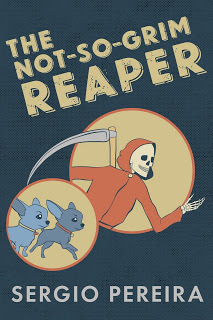 Sergio Pereira: If I'd known this was a party to discuss the pitfalls of Twitter, I would've brought chips and grape juice. In all seriousness, thanks for the intro and the editing of The Not-So-Grim Reaper. You've pretty much nailed the exact angle I was going for with your description of it. In fact, the first time you mentioned Bill & Ted, I punched the air and said, "Yes! Someone got it!" Sometimes, I fear the world has forgotten about Keanu Reeves's greatest role in lieu of The Matrix and John Wick…
Sergio Pereira: If I'd known this was a party to discuss the pitfalls of Twitter, I would've brought chips and grape juice. In all seriousness, thanks for the intro and the editing of The Not-So-Grim Reaper. You've pretty much nailed the exact angle I was going for with your description of it. In fact, the first time you mentioned Bill & Ted, I punched the air and said, "Yes! Someone got it!" Sometimes, I fear the world has forgotten about Keanu Reeves's greatest role in lieu of The Matrix and John Wick…
ND: I’ve seen a pile of grim reapers show up in slush during my travels, but you’ve breathed life into the trope with your humour. I’ll admit it’s not *quite* my usual genre, but I did find myself chuckling most inappropriately while I was working through your manuscript. What do you reckon makes humour tick in fiction, considering you don’t have the visuals to go with the routines…
SP: Good question. Much like comedy in any other medium, it needs to be relatable. People love to laugh at themselves, so you need to make the punchline about something they understand. We might be playing in an odd world where grim reapers, magic, and hellhounds exist, but you’ll still identify with the key concepts of bureaucracy, working a job you hate, and disliking your neighbour. That’s where the humour is found; in what we regard as the usual. Watch any good comedian and see that the strongest laughs come from the ordinary.
ND: What I quite enjoyed about your story was that even though it was often quite absurd at times, there is an underlying sincerity to your main characters – and perhaps a key theme I feel is that of friendship and loyalty. This I found quite refreshing, to be quite honest. Care to add a little more about this?
SP: When I was a child, my grandmother told me that you'll have many acquaintances in life but few friends. I never understood what she meant until I was much older. It might sound cynical, but there aren't that many people who'll be there for you when the going gets tough. Most of them will be around when things are good, but as soon as the stormy weather hits they'll hightail it. In The Not-So-Grim Reaper, the main characters experience how friendship isn't always easy and they do stumble; however, by remaining true to themselves and others, they realise how rare and precious it is to have something so special in their lives.
ND: Oh, I totally relate to this. But now, to change tack – let’s talk about chihuahuas. What makes them truly evil?
SP: Absolutely nothing! My girlfriend had a chihuahua, and he was the most protective dog I've ever seen. He might've been the size of a shoe, but he'd protect her. Much like a cat sees itself as a lion, I think chihuahuas view themselves as wolves (or hellhounds). I love animals and will try to make them a huge part of my stories in a big way. In fact, the one thing that’ll make me turn off a movie or TV show or throw down a book is if an animal dies. Kill off all humanity if you want to, but don’t you dare hurt the fluffs.
ND: My experiences with chihuahuas have not been as positive. My mother had two ankle-snappers that terrorised me when I was a child. In hindsight I realise they were just trying to protect her from the thumping, clumsy idiot sprog of hers running through the house. But gosh, darnit, they drew blood. Chihuahuas may be small, but when you’re three, they’re bloody terrifying. But let’s chat about your cover art quickly – you’ve employed the talents of the wonderful Cristy Zinn, and I think she’s really outdone herself.
SP: I know, right? I’d seen Cristy’s work on Skolion’s books, as well as her mock-ups on Looma Design’s Facebook page. When I saw the Coraline one - which is one of my favourite books, by the way – I knew that she could create something apt and special. I reached out and she was available. So, I gave her a brief idea of what I had in mind and she came back with this incredible cover. If I had an unlimited budget, I would’ve asked her to do illustrations for the book, too. Alas, I still needed to eat this month. Two-minute noodles aren’t so cheap anymore.
SP: Thanks for hosting me!
ND: And I wish you well with this tale, Sergio. Here’s hoping for many five-star reviews.
 Follow Sergio on social media at: www.twitter.com/sergiowrites; www.facebook.com/sergiopereira27; www.instagram.com/sergiowrites
Follow Sergio on social media at: www.twitter.com/sergiowrites; www.facebook.com/sergiopereira27; www.instagram.com/sergiowrites
You can purchase your copy of the Not-So-Grim Reaper at Amazon and Google Play.
About Sergio:
SERGIO PEREIRA is a speculative fiction author and journalist from Johannesburg, South Africa. He has a strong interest in comic books, film, music, and comedy. His short stories have appeared in various magazines and anthologies, such as Devolution Z, Sirens Call Publications's Monster Brawl!, Centum Press's 100 Voices, and Tales from the Lake: Vol. 3 from Crystal Lake Publishing. He is his dog’s favourite author.
 Sergio Pereira: If I'd known this was a party to discuss the pitfalls of Twitter, I would've brought chips and grape juice. In all seriousness, thanks for the intro and the editing of The Not-So-Grim Reaper. You've pretty much nailed the exact angle I was going for with your description of it. In fact, the first time you mentioned Bill & Ted, I punched the air and said, "Yes! Someone got it!" Sometimes, I fear the world has forgotten about Keanu Reeves's greatest role in lieu of The Matrix and John Wick…
Sergio Pereira: If I'd known this was a party to discuss the pitfalls of Twitter, I would've brought chips and grape juice. In all seriousness, thanks for the intro and the editing of The Not-So-Grim Reaper. You've pretty much nailed the exact angle I was going for with your description of it. In fact, the first time you mentioned Bill & Ted, I punched the air and said, "Yes! Someone got it!" Sometimes, I fear the world has forgotten about Keanu Reeves's greatest role in lieu of The Matrix and John Wick…ND: I’ve seen a pile of grim reapers show up in slush during my travels, but you’ve breathed life into the trope with your humour. I’ll admit it’s not *quite* my usual genre, but I did find myself chuckling most inappropriately while I was working through your manuscript. What do you reckon makes humour tick in fiction, considering you don’t have the visuals to go with the routines…
SP: Good question. Much like comedy in any other medium, it needs to be relatable. People love to laugh at themselves, so you need to make the punchline about something they understand. We might be playing in an odd world where grim reapers, magic, and hellhounds exist, but you’ll still identify with the key concepts of bureaucracy, working a job you hate, and disliking your neighbour. That’s where the humour is found; in what we regard as the usual. Watch any good comedian and see that the strongest laughs come from the ordinary.
ND: What I quite enjoyed about your story was that even though it was often quite absurd at times, there is an underlying sincerity to your main characters – and perhaps a key theme I feel is that of friendship and loyalty. This I found quite refreshing, to be quite honest. Care to add a little more about this?
SP: When I was a child, my grandmother told me that you'll have many acquaintances in life but few friends. I never understood what she meant until I was much older. It might sound cynical, but there aren't that many people who'll be there for you when the going gets tough. Most of them will be around when things are good, but as soon as the stormy weather hits they'll hightail it. In The Not-So-Grim Reaper, the main characters experience how friendship isn't always easy and they do stumble; however, by remaining true to themselves and others, they realise how rare and precious it is to have something so special in their lives.
ND: Oh, I totally relate to this. But now, to change tack – let’s talk about chihuahuas. What makes them truly evil?
SP: Absolutely nothing! My girlfriend had a chihuahua, and he was the most protective dog I've ever seen. He might've been the size of a shoe, but he'd protect her. Much like a cat sees itself as a lion, I think chihuahuas view themselves as wolves (or hellhounds). I love animals and will try to make them a huge part of my stories in a big way. In fact, the one thing that’ll make me turn off a movie or TV show or throw down a book is if an animal dies. Kill off all humanity if you want to, but don’t you dare hurt the fluffs.
ND: My experiences with chihuahuas have not been as positive. My mother had two ankle-snappers that terrorised me when I was a child. In hindsight I realise they were just trying to protect her from the thumping, clumsy idiot sprog of hers running through the house. But gosh, darnit, they drew blood. Chihuahuas may be small, but when you’re three, they’re bloody terrifying. But let’s chat about your cover art quickly – you’ve employed the talents of the wonderful Cristy Zinn, and I think she’s really outdone herself.
SP: I know, right? I’d seen Cristy’s work on Skolion’s books, as well as her mock-ups on Looma Design’s Facebook page. When I saw the Coraline one - which is one of my favourite books, by the way – I knew that she could create something apt and special. I reached out and she was available. So, I gave her a brief idea of what I had in mind and she came back with this incredible cover. If I had an unlimited budget, I would’ve asked her to do illustrations for the book, too. Alas, I still needed to eat this month. Two-minute noodles aren’t so cheap anymore.
SP: Thanks for hosting me!
ND: And I wish you well with this tale, Sergio. Here’s hoping for many five-star reviews.
 Follow Sergio on social media at: www.twitter.com/sergiowrites; www.facebook.com/sergiopereira27; www.instagram.com/sergiowrites
Follow Sergio on social media at: www.twitter.com/sergiowrites; www.facebook.com/sergiopereira27; www.instagram.com/sergiowrites You can purchase your copy of the Not-So-Grim Reaper at Amazon and Google Play.
About Sergio:
SERGIO PEREIRA is a speculative fiction author and journalist from Johannesburg, South Africa. He has a strong interest in comic books, film, music, and comedy. His short stories have appeared in various magazines and anthologies, such as Devolution Z, Sirens Call Publications's Monster Brawl!, Centum Press's 100 Voices, and Tales from the Lake: Vol. 3 from Crystal Lake Publishing. He is his dog’s favourite author.
Published on September 27, 2018 02:52
September 3, 2018
Rogue Wave by Jennifer Donnelly
A while back I reviewed the first in Jennifer Donnelly’s Waterfire Saga, Deep Blue. Book two, Rogue Wave, landed on my desk too, so I reckon it’s only fair that I give this one a spin too. Okay, so my verdict is thus: if you’re a big fan of Disney princesses and mermaids, this series will be your crack. While I’m most certainly not the target market in this respect, I quite enjoyed Rogue Wave – perhaps even a bit more than I did book one.
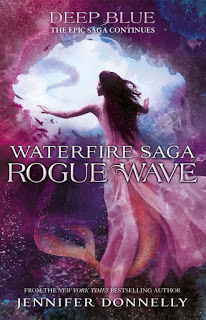 However, if you’re like me and know something about marine ecology, you’ll probably notice all the impossibilities in terms of environment, but I had to keep pinching myself and reminding myself that this is primarily a fantasy story meant for middle grade readers.
However, if you’re like me and know something about marine ecology, you’ll probably notice all the impossibilities in terms of environment, but I had to keep pinching myself and reminding myself that this is primarily a fantasy story meant for middle grade readers.
“Don’t ruin it for them!” in other words. (I have to keep reminding myself, all right?)
In Rogue Wave we mainly follow the doings of the heir to the throne of Miromara, Serafina, and her friends Neela. They’re on a desperate mission to save their world from the predations of the evil Captain Traho and his death riders. For the target age group, there’s quite a bit of Games of Thrones-esque intrigue (minus the naughty bits, of course), and piles of hair-raising situations.
Donnelly has painted a vivid world that in an almost absurd way plays on all the standard tropes we know and love in a good Disney kiddies’ film, yet it has an underlying dash of grit to stop the story from becoming too saccharine. There are times when I felt that the adults depicted are a bit too oblivious, but overall, this ended up being a fun read. With mermaids, of course, and a few scatterings of ridiculous plays on words.
 However, if you’re like me and know something about marine ecology, you’ll probably notice all the impossibilities in terms of environment, but I had to keep pinching myself and reminding myself that this is primarily a fantasy story meant for middle grade readers.
However, if you’re like me and know something about marine ecology, you’ll probably notice all the impossibilities in terms of environment, but I had to keep pinching myself and reminding myself that this is primarily a fantasy story meant for middle grade readers.“Don’t ruin it for them!” in other words. (I have to keep reminding myself, all right?)
In Rogue Wave we mainly follow the doings of the heir to the throne of Miromara, Serafina, and her friends Neela. They’re on a desperate mission to save their world from the predations of the evil Captain Traho and his death riders. For the target age group, there’s quite a bit of Games of Thrones-esque intrigue (minus the naughty bits, of course), and piles of hair-raising situations.
Donnelly has painted a vivid world that in an almost absurd way plays on all the standard tropes we know and love in a good Disney kiddies’ film, yet it has an underlying dash of grit to stop the story from becoming too saccharine. There are times when I felt that the adults depicted are a bit too oblivious, but overall, this ended up being a fun read. With mermaids, of course, and a few scatterings of ridiculous plays on words.
Published on September 03, 2018 11:36
September 1, 2018
Elves: Once Walked with Gods by James Barclay
Elves: Once Walked with Gods by James Barclay is a book I wanted to like, and certainly the premise was solid enough to catch my fancy, but I struggled to finish the story. It’s not that the writing is terrible – it’s just that the author’s style seems to be adequate rather than enchanting, if that makes sense.
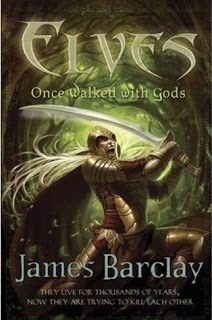 The bare bones of the story is that the elves once suffered a terrible defeat on their home world, and only barely escaped to a new world. Except their leader, one Takaar, shamed himself by running away during that first conflict and has spent the past while going quietly mad out in the forest while his people continue without him.
The bare bones of the story is that the elves once suffered a terrible defeat on their home world, and only barely escaped to a new world. Except their leader, one Takaar, shamed himself by running away during that first conflict and has spent the past while going quietly mad out in the forest while his people continue without him.
A concept I quite liked was that Barclay’s elves aren’t all immortal - there are different lineages or threads, as he calls them, that have different lifespans. This is also a source of internal conflict for the elves, obviously with the more longer-lived threads lording it over the ones with briefer lives. And it’s this very same conflict that makes them vulnerable when humans invade.
While the elves have elite warriors, who’re absolutely super in battle, the humans have access to devastating magic. It’s pretty clear early on that things are going to go wrong, in a bad way. The setting was pretty interesting too – Barclay decided on a rainforest where the primary conflict takes place. So that was a bit different from the usual offerings. I do admit, however, I’m an old-school team elven – so I’m not nuts about the idea of elves growing beards, but that’s Barclay’s world building for you. At least they shave, I guess. (Yes, yes, ruined by Tolkien; I admit it freely.)
Another gripe I had with the story was that I don’t feel as if Barclay delved deep enough into characters’ motivations or emotions – he has a large cast, some of whom only have brief appearances. So it’s difficult to keep track of who is who, and who did what to whom. Also, there’s a lot of history and special terms tossed about, so it takes a while to get into the flow. Mostly, I just felt frustrated, because I couldn’t really get into any of the characters fully.
Look, this is not a bad story. If you prefer your fantasy action packed and fast paced, with loads of combat, you’re most likely going to be reading this story for those exact reasons, and then this book is fine. Unfortunately, I’m not that reader, and I wanted more. This is also clearly book one in a series, so don’t expect a grand ending with all the loose ends neatly tied with ribbons. Unfortunately I’m not invested enough to pick up the rest.
 The bare bones of the story is that the elves once suffered a terrible defeat on their home world, and only barely escaped to a new world. Except their leader, one Takaar, shamed himself by running away during that first conflict and has spent the past while going quietly mad out in the forest while his people continue without him.
The bare bones of the story is that the elves once suffered a terrible defeat on their home world, and only barely escaped to a new world. Except their leader, one Takaar, shamed himself by running away during that first conflict and has spent the past while going quietly mad out in the forest while his people continue without him.A concept I quite liked was that Barclay’s elves aren’t all immortal - there are different lineages or threads, as he calls them, that have different lifespans. This is also a source of internal conflict for the elves, obviously with the more longer-lived threads lording it over the ones with briefer lives. And it’s this very same conflict that makes them vulnerable when humans invade.
While the elves have elite warriors, who’re absolutely super in battle, the humans have access to devastating magic. It’s pretty clear early on that things are going to go wrong, in a bad way. The setting was pretty interesting too – Barclay decided on a rainforest where the primary conflict takes place. So that was a bit different from the usual offerings. I do admit, however, I’m an old-school team elven – so I’m not nuts about the idea of elves growing beards, but that’s Barclay’s world building for you. At least they shave, I guess. (Yes, yes, ruined by Tolkien; I admit it freely.)
Another gripe I had with the story was that I don’t feel as if Barclay delved deep enough into characters’ motivations or emotions – he has a large cast, some of whom only have brief appearances. So it’s difficult to keep track of who is who, and who did what to whom. Also, there’s a lot of history and special terms tossed about, so it takes a while to get into the flow. Mostly, I just felt frustrated, because I couldn’t really get into any of the characters fully.
Look, this is not a bad story. If you prefer your fantasy action packed and fast paced, with loads of combat, you’re most likely going to be reading this story for those exact reasons, and then this book is fine. Unfortunately, I’m not that reader, and I wanted more. This is also clearly book one in a series, so don’t expect a grand ending with all the loose ends neatly tied with ribbons. Unfortunately I’m not invested enough to pick up the rest.
Published on September 01, 2018 08:12
August 28, 2018
Treasure Island by Robert Louis Stevenson
Treasure Island by Robert Louis Stevenson is one of those stories that many of us may have encountered in other forms – I recall a children’s anime series from 1978, directed by Osamu Dezaki. I also recall illustrated children’s books that had the story most likely highly condensed. And that was about it for me.
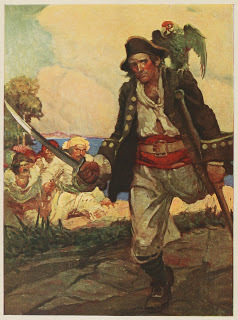 So it was out of curiosity that I picked up the original (you can download it for free from Project Gutenberg) – just to see how I would respond to it as an adult.
So it was out of curiosity that I picked up the original (you can download it for free from Project Gutenberg) – just to see how I would respond to it as an adult.
Okay, so I make no apologies, I love pirate stories. I also love morally ambiguous characters (Long John Silver fan right here). Here goes.
While at a glance, Treasure Island is very much a coming-of-age story for our young Jim Hawkins, and is underpinned by a strong sense of lawful good vs. chaotic evil (sorry, I couldn’t help but throw in some RPG terms here), I gain the sense that the story is more about Long John Silver’s quest to steal himself some treasure, and view his story through the eyes of our unreliable young narrator Jim Hawkins, who has stumbled onto the ending of an epic battle.
We are offered a glimpse into the often brutal and mostly violent lives of pirates – men who live on the edge. They risk much and often gain nothing, but the payoff to those savvy enough to stay ahead of the pack is immense – um, there’s treasure involved. Beyond this being an adventure-filled quest, this is also a story about loyalty and, I feel, a kind of subverted father/son relationship between Jim and Long John Silver.
The writing itself is fast paced but laden with so many nautical terms and near incomprehensible dialect between the pirates. So while the story has some sort of authentic feel to it, the narrative may lose readers for the aforementioned. Another thing is that we don’t ever really get a sense of Jim’s feelings – he seems very level headed for one so young as he. Stevenson doesn’t really delve into the emotional side of things, which makes it difficult sometimes to get a full grasp on what motivates Jim.
Overall, this is a quick read, and I’m glad I’ve tucked this one under my belt. At its very bones, there’s a lovely story here that offers fodder for further story seeds. Not for everyone, I suspect, but I do feel strongly that it’s important to dip into the classics from time to time.
 So it was out of curiosity that I picked up the original (you can download it for free from Project Gutenberg) – just to see how I would respond to it as an adult.
So it was out of curiosity that I picked up the original (you can download it for free from Project Gutenberg) – just to see how I would respond to it as an adult.Okay, so I make no apologies, I love pirate stories. I also love morally ambiguous characters (Long John Silver fan right here). Here goes.
While at a glance, Treasure Island is very much a coming-of-age story for our young Jim Hawkins, and is underpinned by a strong sense of lawful good vs. chaotic evil (sorry, I couldn’t help but throw in some RPG terms here), I gain the sense that the story is more about Long John Silver’s quest to steal himself some treasure, and view his story through the eyes of our unreliable young narrator Jim Hawkins, who has stumbled onto the ending of an epic battle.
We are offered a glimpse into the often brutal and mostly violent lives of pirates – men who live on the edge. They risk much and often gain nothing, but the payoff to those savvy enough to stay ahead of the pack is immense – um, there’s treasure involved. Beyond this being an adventure-filled quest, this is also a story about loyalty and, I feel, a kind of subverted father/son relationship between Jim and Long John Silver.
The writing itself is fast paced but laden with so many nautical terms and near incomprehensible dialect between the pirates. So while the story has some sort of authentic feel to it, the narrative may lose readers for the aforementioned. Another thing is that we don’t ever really get a sense of Jim’s feelings – he seems very level headed for one so young as he. Stevenson doesn’t really delve into the emotional side of things, which makes it difficult sometimes to get a full grasp on what motivates Jim.
Overall, this is a quick read, and I’m glad I’ve tucked this one under my belt. At its very bones, there’s a lovely story here that offers fodder for further story seeds. Not for everyone, I suspect, but I do feel strongly that it’s important to dip into the classics from time to time.
Published on August 28, 2018 05:28
August 15, 2018
Knee-Deep in Grit edited by Adrian Collins and Mike Myers
I’m one of those who love my SFF gritty and dark, so when the opportunity arose to review a copy of Knee-Deep in Grit, an anthology of 26 GrimDark SFF short stories edited by Adrian Collins and Mike Myers, I elbowed my way to the front of the queue yelling, “Pick me! Pick me!”
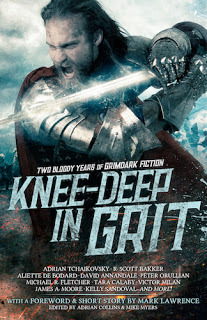 This anthology features tales by the likes of Adrian Tchaikovsky, R Scott Bakker, Aliette de Bodard, David Annandale, Peter Orullian, Michael R Fletcher, Tara Calaby, Victor Milan, James A Moore, Kelly Sandoval and others who featured in the past two years of Grimdark Magazine issues. There are far too many tales that I enjoyed for me to write about them all, but I’ll pick out the ones that really worked for me.
This anthology features tales by the likes of Adrian Tchaikovsky, R Scott Bakker, Aliette de Bodard, David Annandale, Peter Orullian, Michael R Fletcher, Tara Calaby, Victor Milan, James A Moore, Kelly Sandoval and others who featured in the past two years of Grimdark Magazine issues. There are far too many tales that I enjoyed for me to write about them all, but I’ll pick out the ones that really worked for me.
What I love about GrimDark is that it takes characters into awful situations and leaves them with equally awful solutions. Sometimes for the better, more often for the worse (even if they succeed). There are few if any redeemable characters in these stories. The heroes have tarnished armour.
“The King Beneath the Waves” by Peter Fugazzotto was one of those stories that feels as if it should be part of a larger body of work. We follow the point of view of Werting, who’s been taken in by a band of raiders whose ship has been wrecked off an uninhabited coast. He’s at the bottom of the pecking order, but this is not necessarily a bad thing when an ancient cursed treasure is found, and the raiders inevitably fall prey to their greed. I loved this story, for the hints of a history, of dark magic… and perhaps also just because I loved the forbidding environment the author creates.
“At the Walls of Sinnlos” by Michael R Fletcher is a story about loyalty, about how men are twisted to the ends of others – their lives distorted and, I daresay, wasted in war. There’s something to be said for a story where you know there’s going to be no happy outcome, how people justify their actions right at the end. Here we have a mage whose power is the last resort to end a war, and it’s not pretty. This one got me with a gut punch.
“The Right Hand of Decay” by David Annandale made me hurt. In theme it was very similar to the preceding story by Fletcher. Here, we have a castle that is under siege and it looks like a hopeless cause as The Grey Queen piles corpses before the castle. One by one her loyal soldiers sacrifice themselves on this growing mound until… No. I won’t spoil it for you. This is about loyalty and war, and the devastating consequences, I’d say, of pride.
“All the Lovely Brides” by Kelly Sandoval really worked well for me. We follow Lydra as she is prepared for a sacrifice in what appears to be an order of ritual brides known as the Chosen who, every five years, are killed in order to renew the rule of their master. Sandoval explores the complex emotions of a woman who realises she’s not ready nor willing to make that ultimate sacrifice. The outcome was…just perfect.
There was something wonderfully dark and absurd about Siobhan Gallagher’s “A Recipe for Corpse Oil” that worked for me. We follow the fortunes of the pickpocket Tavin, when he finds himself tasked to collect chins for a recipe for corpse oil. I mean, you can live without a chin, right? This was a lighter story for me than the others, and perhaps a perfect relief from the intensity.
“A Fair Man” by Peter Orullian hurt in all the right places. Mikel is a good man working for a corrupt system, and though he is just following orders, to give him some credit, he does try to do good. But a good man in a bad system can only be pushed so far… And the consequences can topple an empire. This one’s a solid read.
“Lessons of Necessity” by TC Powell takes place post-zombiepocalypse, not my favourite genre, but as I always say, it’s not the setting but *what* the author does with it that counts. And Powell makes it count. A short and heart-rending story that hit me right in the feels.
I’m no fan of rats, and “Viva Longevicus” by Brandon Daubs played on my misgivings about the critters. He asks a lovely question: What if a genetically engineered pet becomes the worst invasive pest imaginable? I mean, these little suckers are so cute, you just want to squeeze them until… No, not that. But I loved the contrast of these tough, hard-bitten exterminators going around with flamethrowers and guns, going up against the cute-but-deadly critters. It would have been comical if it hadn’t … well … I don’t know if any of you saw that episode of MacGyver where his buddy got eaten by swarming army ants? Or, wait, am I showing my age here? Anyhoo, hijinks ensue and this is a nasty, brutal little tail. Ahem. Tale.
“Against the Encroaching Darkness” by Aliette de Bodard is underpinned by her suitably lush, lyrical style, but with an underlying grit that makes me shiver in delight. We are told that this takes place in Paris, but it’s not the Paris we think we know. The setting seems to be Victorian but we know there are magical houses that draw their power from the number of Fallen children they have – as in Fallen angels. I love the fact that I felt as if I was only brushing the tip of a world of secrets and mysteries, and wished like hell I could read more set in this world. In order to protect her House Lazarus, Victoire realises that a sacrifice needs to be made. And sometimes being weak is a strength. I’ll leave it at that.
Last but not least, “Bad Seed” by Mark Lawrence takes me back to familiar turf as we have an origin story for a beloved character from his Broken Empire. Even killers have motivations, and here we discover what broke Allan Oak, and why life as a simple farmer, at the mercy of hard men, would not be his fate.
Grimdark Magazine is a publication that I support whenever I have the opportunity, especially in the light of so many markets going belly up in current climes. If this is the sort of SFF you enjoy, you can’t go wrong in supporting. They even have a Patreon page. They’ve won me over with the incredible quality of the publication and the stories they selected. Well done to the authors and editors on this anthology. It’s absolutely perfect, and should have a little something for most readers of SFF.
 This anthology features tales by the likes of Adrian Tchaikovsky, R Scott Bakker, Aliette de Bodard, David Annandale, Peter Orullian, Michael R Fletcher, Tara Calaby, Victor Milan, James A Moore, Kelly Sandoval and others who featured in the past two years of Grimdark Magazine issues. There are far too many tales that I enjoyed for me to write about them all, but I’ll pick out the ones that really worked for me.
This anthology features tales by the likes of Adrian Tchaikovsky, R Scott Bakker, Aliette de Bodard, David Annandale, Peter Orullian, Michael R Fletcher, Tara Calaby, Victor Milan, James A Moore, Kelly Sandoval and others who featured in the past two years of Grimdark Magazine issues. There are far too many tales that I enjoyed for me to write about them all, but I’ll pick out the ones that really worked for me.What I love about GrimDark is that it takes characters into awful situations and leaves them with equally awful solutions. Sometimes for the better, more often for the worse (even if they succeed). There are few if any redeemable characters in these stories. The heroes have tarnished armour.
“The King Beneath the Waves” by Peter Fugazzotto was one of those stories that feels as if it should be part of a larger body of work. We follow the point of view of Werting, who’s been taken in by a band of raiders whose ship has been wrecked off an uninhabited coast. He’s at the bottom of the pecking order, but this is not necessarily a bad thing when an ancient cursed treasure is found, and the raiders inevitably fall prey to their greed. I loved this story, for the hints of a history, of dark magic… and perhaps also just because I loved the forbidding environment the author creates.
“At the Walls of Sinnlos” by Michael R Fletcher is a story about loyalty, about how men are twisted to the ends of others – their lives distorted and, I daresay, wasted in war. There’s something to be said for a story where you know there’s going to be no happy outcome, how people justify their actions right at the end. Here we have a mage whose power is the last resort to end a war, and it’s not pretty. This one got me with a gut punch.
“The Right Hand of Decay” by David Annandale made me hurt. In theme it was very similar to the preceding story by Fletcher. Here, we have a castle that is under siege and it looks like a hopeless cause as The Grey Queen piles corpses before the castle. One by one her loyal soldiers sacrifice themselves on this growing mound until… No. I won’t spoil it for you. This is about loyalty and war, and the devastating consequences, I’d say, of pride.
“All the Lovely Brides” by Kelly Sandoval really worked well for me. We follow Lydra as she is prepared for a sacrifice in what appears to be an order of ritual brides known as the Chosen who, every five years, are killed in order to renew the rule of their master. Sandoval explores the complex emotions of a woman who realises she’s not ready nor willing to make that ultimate sacrifice. The outcome was…just perfect.
There was something wonderfully dark and absurd about Siobhan Gallagher’s “A Recipe for Corpse Oil” that worked for me. We follow the fortunes of the pickpocket Tavin, when he finds himself tasked to collect chins for a recipe for corpse oil. I mean, you can live without a chin, right? This was a lighter story for me than the others, and perhaps a perfect relief from the intensity.
“A Fair Man” by Peter Orullian hurt in all the right places. Mikel is a good man working for a corrupt system, and though he is just following orders, to give him some credit, he does try to do good. But a good man in a bad system can only be pushed so far… And the consequences can topple an empire. This one’s a solid read.
“Lessons of Necessity” by TC Powell takes place post-zombiepocalypse, not my favourite genre, but as I always say, it’s not the setting but *what* the author does with it that counts. And Powell makes it count. A short and heart-rending story that hit me right in the feels.
I’m no fan of rats, and “Viva Longevicus” by Brandon Daubs played on my misgivings about the critters. He asks a lovely question: What if a genetically engineered pet becomes the worst invasive pest imaginable? I mean, these little suckers are so cute, you just want to squeeze them until… No, not that. But I loved the contrast of these tough, hard-bitten exterminators going around with flamethrowers and guns, going up against the cute-but-deadly critters. It would have been comical if it hadn’t … well … I don’t know if any of you saw that episode of MacGyver where his buddy got eaten by swarming army ants? Or, wait, am I showing my age here? Anyhoo, hijinks ensue and this is a nasty, brutal little tail. Ahem. Tale.
“Against the Encroaching Darkness” by Aliette de Bodard is underpinned by her suitably lush, lyrical style, but with an underlying grit that makes me shiver in delight. We are told that this takes place in Paris, but it’s not the Paris we think we know. The setting seems to be Victorian but we know there are magical houses that draw their power from the number of Fallen children they have – as in Fallen angels. I love the fact that I felt as if I was only brushing the tip of a world of secrets and mysteries, and wished like hell I could read more set in this world. In order to protect her House Lazarus, Victoire realises that a sacrifice needs to be made. And sometimes being weak is a strength. I’ll leave it at that.
Last but not least, “Bad Seed” by Mark Lawrence takes me back to familiar turf as we have an origin story for a beloved character from his Broken Empire. Even killers have motivations, and here we discover what broke Allan Oak, and why life as a simple farmer, at the mercy of hard men, would not be his fate.
Grimdark Magazine is a publication that I support whenever I have the opportunity, especially in the light of so many markets going belly up in current climes. If this is the sort of SFF you enjoy, you can’t go wrong in supporting. They even have a Patreon page. They’ve won me over with the incredible quality of the publication and the stories they selected. Well done to the authors and editors on this anthology. It’s absolutely perfect, and should have a little something for most readers of SFF.
Published on August 15, 2018 01:20
August 12, 2018
The Dreamer's Tears by Cristy Zinn
My only complaint with The Dreamer’s Tears by Cristy Zinn is that it’s clearly a book one in a series that still needs to be written, and I immediately needed to know more once I’d reached the end.
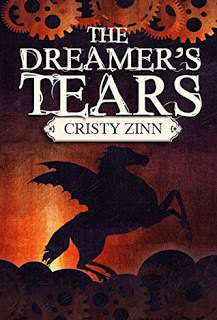 In this story, we meet Ivy Bauble, who lives in the little village of Newton. She’s accident prone and incurably curious. The last thing she expects is that she will become apprenticed to the Master Borinvere, who maintains the magical tower that protects the village from marauding Knightmares.
In this story, we meet Ivy Bauble, who lives in the little village of Newton. She’s accident prone and incurably curious. The last thing she expects is that she will become apprenticed to the Master Borinvere, who maintains the magical tower that protects the village from marauding Knightmares.
Zinn’s writing is highly imaginative, heartfelt and whimsical, and this is the kind of story I could well imagine a parent reading to a child for bedtime … or perhaps just enjoying for themselves. Zinn’s language flows musically, and would be a delight on the ears.
She has created a tactile, believable world filled with fascinating characters and a history, that feels as if it has a mythic resonance. I’d have loved for book one to go on a bit longer, to offer a little more resolution, as the ending rushed up quite abruptly, but there’s enough here to have me hooked and wanting more.
 In this story, we meet Ivy Bauble, who lives in the little village of Newton. She’s accident prone and incurably curious. The last thing she expects is that she will become apprenticed to the Master Borinvere, who maintains the magical tower that protects the village from marauding Knightmares.
In this story, we meet Ivy Bauble, who lives in the little village of Newton. She’s accident prone and incurably curious. The last thing she expects is that she will become apprenticed to the Master Borinvere, who maintains the magical tower that protects the village from marauding Knightmares.Zinn’s writing is highly imaginative, heartfelt and whimsical, and this is the kind of story I could well imagine a parent reading to a child for bedtime … or perhaps just enjoying for themselves. Zinn’s language flows musically, and would be a delight on the ears.
She has created a tactile, believable world filled with fascinating characters and a history, that feels as if it has a mythic resonance. I’d have loved for book one to go on a bit longer, to offer a little more resolution, as the ending rushed up quite abruptly, but there’s enough here to have me hooked and wanting more.
Published on August 12, 2018 07:48
July 22, 2018
The Frontier Lord by Duncan M Hamilton
The Frontier Lord by Duncan M Hamilton was sent to me as a freebie when I joined his mailing list, and it sat there in my Kindle app for a while. I’m glad I gave it a go and it’s a short read, reminiscent of Alexandre Dumas but moving at a far better pace and without all the digressions Dumas is so fond of (yes, I’m not even halfway with the Count of Monte Cristo for the past three-odd years).
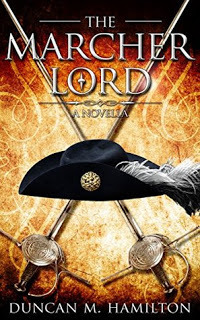 So if you’re into the kind of mythos surrounding the likes of the Three Musketeers, then you’ll most likely be giddy reading The Frontier Lord, and if you’re into sword fighting, like I am, then you’ll most certainly enjoy this story. The fight scenes are clearly realised and have an authentic feel to them.
So if you’re into the kind of mythos surrounding the likes of the Three Musketeers, then you’ll most likely be giddy reading The Frontier Lord, and if you’re into sword fighting, like I am, then you’ll most certainly enjoy this story. The fight scenes are clearly realised and have an authentic feel to them.
We follow Rolf, whose father is the marquis of a border Marches that are currently under threat from invasion. The marquis is taking his son through to the city of Mirabay so that they can petition the king for assistance. Rolf has never been to the city before, and he’s a good lad, who’s been fighting since a young age. So he’s an experienced warrior, even at the tender age of 19.
Except he’s woefully naive when it comes to the meanderings of high society in the big city. He’s grown up on stories about the legendary Silver Circle who serve the king, noble swordsmen who engage in heroic acts. He’s not prepared for the somewhat foppish gentlemen who challenge him to duels after minor slights get blown out of proportion.
What follows is a whimsical yet also poignant coming of age for this young man, as he navigates Mirabay’s somewhat murky politics. Overall, I enjoyed this novella immensely. It was a light, fun read, despite a few editing gremlins that slipped through (they weren’t enough to become deal breakers for me). I would have liked to see more layered descriptions, but Hamilton’s voice is strong and I loved his characterisation.
 So if you’re into the kind of mythos surrounding the likes of the Three Musketeers, then you’ll most likely be giddy reading The Frontier Lord, and if you’re into sword fighting, like I am, then you’ll most certainly enjoy this story. The fight scenes are clearly realised and have an authentic feel to them.
So if you’re into the kind of mythos surrounding the likes of the Three Musketeers, then you’ll most likely be giddy reading The Frontier Lord, and if you’re into sword fighting, like I am, then you’ll most certainly enjoy this story. The fight scenes are clearly realised and have an authentic feel to them.We follow Rolf, whose father is the marquis of a border Marches that are currently under threat from invasion. The marquis is taking his son through to the city of Mirabay so that they can petition the king for assistance. Rolf has never been to the city before, and he’s a good lad, who’s been fighting since a young age. So he’s an experienced warrior, even at the tender age of 19.
Except he’s woefully naive when it comes to the meanderings of high society in the big city. He’s grown up on stories about the legendary Silver Circle who serve the king, noble swordsmen who engage in heroic acts. He’s not prepared for the somewhat foppish gentlemen who challenge him to duels after minor slights get blown out of proportion.
What follows is a whimsical yet also poignant coming of age for this young man, as he navigates Mirabay’s somewhat murky politics. Overall, I enjoyed this novella immensely. It was a light, fun read, despite a few editing gremlins that slipped through (they weren’t enough to become deal breakers for me). I would have liked to see more layered descriptions, but Hamilton’s voice is strong and I loved his characterisation.
Published on July 22, 2018 04:43
July 16, 2018
Highlander: The American Dream
Something that I’ve started to do a bit more often these days is read comic books using my kindle app on my iPad – the experience has been quite painless and thoroughly enjoyable, especially when it comes down to purchasing and downloading collections. My friends will know I’m a huge fan of the Highlander franchise (and pity them, some of them had to put up with my obsession since high school – if one of you’re reading this now, realise that I’m waving at you right now). Lately I’ve been dipping back into the Highlander fandom, and it’s even more enjoyable now since it’s so much easier for me to lay hands on the assorted films, series and books – unlike the early 1990s when the internet wasn’t within the reach of mere mortals.
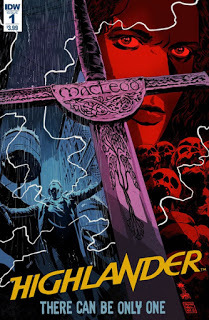 Highlander: The American Dream is a comic series that came out last year (2017) written by Brian Ruckley with art by Andrea Mutti. Generally I tend to be wary of tie-ins but this offering was solid, as in I immediately went back to page through particular sections and I felt that as a prequel The American Dream filled in some gaps for the Connor MacLeod we’ve come to know and love from the first film. More importantly, this offering stays true to the spirit of the very first film, so it will most likely keep the purists happy.
Highlander: The American Dream is a comic series that came out last year (2017) written by Brian Ruckley with art by Andrea Mutti. Generally I tend to be wary of tie-ins but this offering was solid, as in I immediately went back to page through particular sections and I felt that as a prequel The American Dream filled in some gaps for the Connor MacLeod we’ve come to know and love from the first film. More importantly, this offering stays true to the spirit of the very first film, so it will most likely keep the purists happy.
I’m happy enough to add the events here to my headcanon, and themes that are elaborated on are Connor’s loneliness and the burden placed on him and a few other Immortals to counteract the evil of other Immortals such as the Kurgan and, of course the antagonist in The American Dream – John Hooke, who has rather a lot in common with a rabid dog.
We also see the uneasy partnership between Connor and another Immortal, the monk Osta Vazilek (shades of Darius echoing there, perhaps?) as they hunt Hooke down through the ages – so expect hopping between the periods of the American Civil War, the 1950s and the mid-1980s. We also get to see the plucky Rachel in action – and she most certainly has gumption. I’ve always loved her as a character – she dedicated herself to Connor and clearly was utterly devoted to him, despite the fact that he held himself aloof from everyone around him.
Overall, the narrative was engaging – this is a stock-standard “hunt the evil Immortals” battle that dovetails well with the first film. The colouring was lovely; Vladimir Popov has done an excellent job. I especially loved the illustrations between the issues by Claudia Gironi, which evoked Connor so well. As for the art, I’m not hundred percent sure I liked the way Mutti drew Connor or the other characters – there was a lot of sameness in their facial features, and Connor just looked bland without the intensity of the stare that Lambert gifted him in the film. But this wasn’t a deal-breaker for me because the overall production quality was high, and it’s clear that a great deal of thought was put into the visual composition.
 Highlander: The American Dream is a comic series that came out last year (2017) written by Brian Ruckley with art by Andrea Mutti. Generally I tend to be wary of tie-ins but this offering was solid, as in I immediately went back to page through particular sections and I felt that as a prequel The American Dream filled in some gaps for the Connor MacLeod we’ve come to know and love from the first film. More importantly, this offering stays true to the spirit of the very first film, so it will most likely keep the purists happy.
Highlander: The American Dream is a comic series that came out last year (2017) written by Brian Ruckley with art by Andrea Mutti. Generally I tend to be wary of tie-ins but this offering was solid, as in I immediately went back to page through particular sections and I felt that as a prequel The American Dream filled in some gaps for the Connor MacLeod we’ve come to know and love from the first film. More importantly, this offering stays true to the spirit of the very first film, so it will most likely keep the purists happy.I’m happy enough to add the events here to my headcanon, and themes that are elaborated on are Connor’s loneliness and the burden placed on him and a few other Immortals to counteract the evil of other Immortals such as the Kurgan and, of course the antagonist in The American Dream – John Hooke, who has rather a lot in common with a rabid dog.
We also see the uneasy partnership between Connor and another Immortal, the monk Osta Vazilek (shades of Darius echoing there, perhaps?) as they hunt Hooke down through the ages – so expect hopping between the periods of the American Civil War, the 1950s and the mid-1980s. We also get to see the plucky Rachel in action – and she most certainly has gumption. I’ve always loved her as a character – she dedicated herself to Connor and clearly was utterly devoted to him, despite the fact that he held himself aloof from everyone around him.
Overall, the narrative was engaging – this is a stock-standard “hunt the evil Immortals” battle that dovetails well with the first film. The colouring was lovely; Vladimir Popov has done an excellent job. I especially loved the illustrations between the issues by Claudia Gironi, which evoked Connor so well. As for the art, I’m not hundred percent sure I liked the way Mutti drew Connor or the other characters – there was a lot of sameness in their facial features, and Connor just looked bland without the intensity of the stare that Lambert gifted him in the film. But this wasn’t a deal-breaker for me because the overall production quality was high, and it’s clear that a great deal of thought was put into the visual composition.
Published on July 16, 2018 10:39
July 11, 2018
Ander Lewens deur André P Brink
Ander Lewens deur André P Brink sit al 'n lang ruk op my boekrak, en ek is bly dat ek nou finaal klaargekry het met hierdie roman. Ons volg die deurmekaargevlegte lewens van drie mans – David, 'n skilder; Steve, 'n argitek; en Derek, 'n pianis. Van die begin af speel Brink met lesers se sintuie, met kleur, die materiaal, asook musiek en kos.
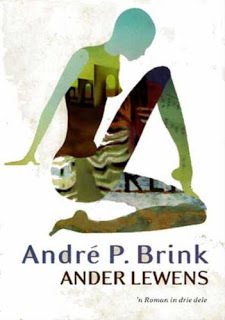 'n Ander tema wat deur die drie stories geweef word is die van vreemdheid, wanneer aspekte van hulle wêreld onbekend word. Elke man definieer vir homself in sy interaksie met sy omgewing, in sy verhoudings met familie en minnaars.
'n Ander tema wat deur die drie stories geweef word is die van vreemdheid, wanneer aspekte van hulle wêreld onbekend word. Elke man definieer vir homself in sy interaksie met sy omgewing, in sy verhoudings met familie en minnaars.
Die drie verhale oorvleuel vir mekaar, en lesers kan sien hoe elke karakter se wêreldbeskouing 'n ander kleur en geur tot die storie oorgee. Partykeer voel ek asof die karakters 'n bietjie te sentimenteel en self-geabsorbeer is, en dinge het dikwels vir my ongemaklik laat voel. Wat 'n goeie ding is, ek dink!
Mense sal seker 'n bietjie ontstoke wees as ek sê hierdie is eintlik maar 'n fantasie-roman (miskien spekulatiewe fiksie) – want daar is elemente van fantasie en tot op 'n mate gruwel. Met alles in ag geneem, het ek Ander Lewens nogal geniet – en dit is deel van my persoonlike uitdaging om meer Afrikaans te lees. En om meer in my moedertaal te skrywe (verskoon tog maar dat my woordeskat so lomp is).
 'n Ander tema wat deur die drie stories geweef word is die van vreemdheid, wanneer aspekte van hulle wêreld onbekend word. Elke man definieer vir homself in sy interaksie met sy omgewing, in sy verhoudings met familie en minnaars.
'n Ander tema wat deur die drie stories geweef word is die van vreemdheid, wanneer aspekte van hulle wêreld onbekend word. Elke man definieer vir homself in sy interaksie met sy omgewing, in sy verhoudings met familie en minnaars.Die drie verhale oorvleuel vir mekaar, en lesers kan sien hoe elke karakter se wêreldbeskouing 'n ander kleur en geur tot die storie oorgee. Partykeer voel ek asof die karakters 'n bietjie te sentimenteel en self-geabsorbeer is, en dinge het dikwels vir my ongemaklik laat voel. Wat 'n goeie ding is, ek dink!
Mense sal seker 'n bietjie ontstoke wees as ek sê hierdie is eintlik maar 'n fantasie-roman (miskien spekulatiewe fiksie) – want daar is elemente van fantasie en tot op 'n mate gruwel. Met alles in ag geneem, het ek Ander Lewens nogal geniet – en dit is deel van my persoonlike uitdaging om meer Afrikaans te lees. En om meer in my moedertaal te skrywe (verskoon tog maar dat my woordeskat so lomp is).
Published on July 11, 2018 09:52



